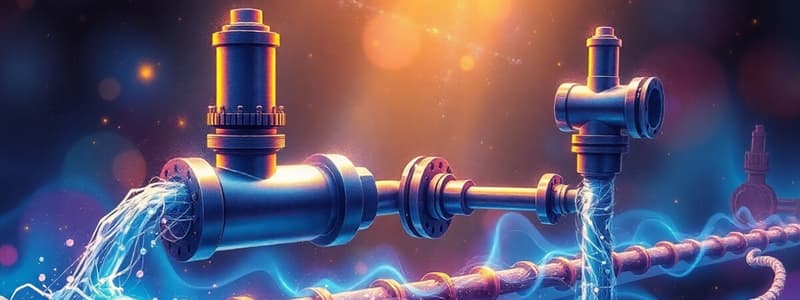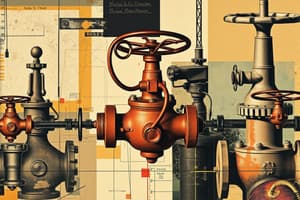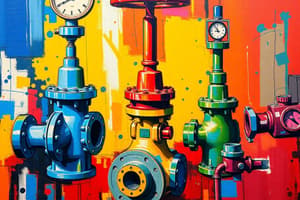Podcast
Questions and Answers
What is a primary characteristic of a single acting spring opposed actuator?
What is a primary characteristic of a single acting spring opposed actuator?
- Requires a constant air supply to maintain position
- Operates solely on mechanical friction without air pressure
- Uses a piston to drive the valve directly
- Utilizes a spring to return the actuator to its default position (correct)
Which type of actuator uses pressure on both sides of the piston to control its position?
Which type of actuator uses pressure on both sides of the piston to control its position?
- Air cushion actuator
- Single acting actuator
- Double acting actuator (correct)
- Diaphragm actuator
What is the main function of a valve positioner?
What is the main function of a valve positioner?
- To match the valve position with the controller output signal (correct)
- To stabilize pressure changes in the system
- To amplify the input signal for better actuator performance
- To manually adjust valve positioning during maintenance
How can a valve positioner modify the relationship between input and output air signals?
How can a valve positioner modify the relationship between input and output air signals?
What does the output pressure gauge on a valve actuator indicate?
What does the output pressure gauge on a valve actuator indicate?
In pneumatic actuation, which component is typically a diaphragm connected to a stem for mechanical advantage?
In pneumatic actuation, which component is typically a diaphragm connected to a stem for mechanical advantage?
What occurs when the signal pressure is reduced in an air cushion type piston actuator?
What occurs when the signal pressure is reduced in an air cushion type piston actuator?
What is the function of instrument input pressure gauge during troubleshooting?
What is the function of instrument input pressure gauge during troubleshooting?
What is the primary function of a control valve in a control loop?
What is the primary function of a control valve in a control loop?
Which component connects the actuator to the valve body in a sliding stem valve system?
Which component connects the actuator to the valve body in a sliding stem valve system?
What role does the actuator play in a control valve system?
What role does the actuator play in a control valve system?
What does the valve positioner respond to in a control valve system?
What does the valve positioner respond to in a control valve system?
In a valve system, what is the purpose of the diaphragm?
In a valve system, what is the purpose of the diaphragm?
What component is typically used to override the actuator's function manually?
What component is typically used to override the actuator's function manually?
What is the function of a regulator in a control valve system?
What is the function of a regulator in a control valve system?
What action is induced by the spring in a control valve system?
What action is induced by the spring in a control valve system?
What is the primary purpose of a globe control valve?
What is the primary purpose of a globe control valve?
What feature distinguishes a three-way control valve from other types?
What feature distinguishes a three-way control valve from other types?
What is the role of the diaphragm in an air regulator?
What is the role of the diaphragm in an air regulator?
How can the output of a controller be reversed?
How can the output of a controller be reversed?
What aspect of butterfly valves contributes to their lower manufacturing costs?
What aspect of butterfly valves contributes to their lower manufacturing costs?
What is a primary advantage of ball or segmented ball control valves?
What is a primary advantage of ball or segmented ball control valves?
What occurs to a control valve in a fail-safe situation?
What occurs to a control valve in a fail-safe situation?
Which actuator type is commonly paired with butterfly control valves?
Which actuator type is commonly paired with butterfly control valves?
What happens to an air to close valve when it loses its instrument air supply?
What happens to an air to close valve when it loses its instrument air supply?
What is the purpose of a lockup relay in a control valve system?
What is the purpose of a lockup relay in a control valve system?
Which actuator response is considered direct acting?
Which actuator response is considered direct acting?
Which statement accurately describes a fail in place condition for control valves?
Which statement accurately describes a fail in place condition for control valves?
How can the combination of actuator and valve actions be determined?
How can the combination of actuator and valve actions be determined?
What occurs during a power failure in an air to open valve?
What occurs during a power failure in an air to open valve?
What is one characteristic of electric motor actuators regarding power loss?
What is one characteristic of electric motor actuators regarding power loss?
If a valve is moving material into a tank and experiences a power failure, what is the potential risk?
If a valve is moving material into a tank and experiences a power failure, what is the potential risk?
What is the first step in the instrument air regulator procedure?
What is the first step in the instrument air regulator procedure?
What happens to the control valve if both the spring and diaphragm actuator are direct acting and air is lost?
What happens to the control valve if both the spring and diaphragm actuator are direct acting and air is lost?
Which component is essential for regulating upstream pressure in a back pressure regulator?
Which component is essential for regulating upstream pressure in a back pressure regulator?
Which of the following valves allows for the addition of material to a tank to stop the flow during a power failure?
Which of the following valves allows for the addition of material to a tank to stop the flow during a power failure?
What type of motion does a butterfly valve utilize to open?
What type of motion does a butterfly valve utilize to open?
Which pressure regulators are utilized to control downstream fluid pressure?
Which pressure regulators are utilized to control downstream fluid pressure?
What is one functionality a valve positioner can provide?
What is one functionality a valve positioner can provide?
What is commonly the most used control valve body style in processing?
What is commonly the most used control valve body style in processing?
Flashcards
I/P transducer function
I/P transducer function
Converts a milliampere electrical signal into a pneumatic pressure signal.
Control valve failure: safe position
Control valve failure: safe position
Control valves move to a predetermined position during power or air failure to prevent system damage.
Fail open control valve
Fail open control valve
A valve that opens when instrument air supply loses pressure.
Fail open application
Fail open application
Signup and view all the flashcards
Fail closed control valve
Fail closed control valve
Signup and view all the flashcards
Fail closed application
Fail closed application
Signup and view all the flashcards
Direct acting actuator
Direct acting actuator
Signup and view all the flashcards
Reverse acting actuator
Reverse acting actuator
Signup and view all the flashcards
Control Valve
Control Valve
Signup and view all the flashcards
Actuator
Actuator
Signup and view all the flashcards
Valve Body
Valve Body
Signup and view all the flashcards
Valve Plug
Valve Plug
Signup and view all the flashcards
Valve Stem
Valve Stem
Signup and view all the flashcards
Valve Seat
Valve Seat
Signup and view all the flashcards
Control Loop
Control Loop
Signup and view all the flashcards
Instrument signal
Instrument signal
Signup and view all the flashcards
Pneumatic actuator subcategories
Pneumatic actuator subcategories
Signup and view all the flashcards
Spring and diaphragm actuator
Spring and diaphragm actuator
Signup and view all the flashcards
Single-acting spring opposed actuator
Single-acting spring opposed actuator
Signup and view all the flashcards
Air cushion piston actuator
Air cushion piston actuator
Signup and view all the flashcards
Double-acting piston actuator
Double-acting piston actuator
Signup and view all the flashcards
Valve positioner function
Valve positioner function
Signup and view all the flashcards
Valve positioner control relationship
Valve positioner control relationship
Signup and view all the flashcards
Valve positioner operations (pressure gauges)
Valve positioner operations (pressure gauges)
Signup and view all the flashcards
Air Supply Pressure Gauge
Air Supply Pressure Gauge
Signup and view all the flashcards
Reversed Controller Output
Reversed Controller Output
Signup and view all the flashcards
Globe Control Valve
Globe Control Valve
Signup and view all the flashcards
Three-way Control Valve
Three-way Control Valve
Signup and view all the flashcards
Butterfly Control Valve
Butterfly Control Valve
Signup and view all the flashcards
Ball Control Valve
Ball Control Valve
Signup and view all the flashcards
Instrument Air Regulator
Instrument Air Regulator
Signup and view all the flashcards
Air Regulator Parts (Inlet)
Air Regulator Parts (Inlet)
Signup and view all the flashcards
Pilot valve assembly
Pilot valve assembly
Signup and view all the flashcards
Back pressure regulator
Back pressure regulator
Signup and view all the flashcards
Pressure reducing regulator
Pressure reducing regulator
Signup and view all the flashcards
Globe valve
Globe valve
Signup and view all the flashcards
Study Notes
Control Loops - Control Valves and Regulators
- Objectives:
- Identify components of a control valve system from a drawing or device.
- Define terms related to valves and final control elements, and understand operating scenarios where they are beneficial.
Reading Summary - Introduction
- Final Control Element: The last active device in a control loop, often a control valve.
- Common Control Valve Components:
- Instrument air actuates the valve.
- Regulates material flow by creating a pressure drop across the valve.
- Actuator converts signals (linear or rotary motion) to control flow mechanisms within the valve body.
- Common valve components include: bodies, bonnets, valve plugs, stems, actuators(spring diaphragm, spring piston, double acting piston).
- Valve plugs move to open or close flow, impacting the flow rate of valves as they move towards/away from the valve seat.
Reading Summary - Control Valve Failure Conditions
- Failure Conditions: Control valve failures due to air loss or other issues.
- Actuators without provisions for returning to a predetermined position in power failure cases can fail to a predetermined intermediate position.
- Engineers choose appropriate valve failure response based on safety criteria.
- Fail Open - Air to close loses, valve opens due to the return spring being more powerful than the diminished supply air (example pressure vessel relief).
- Fail Closed - Air to open fails, valve closes (example tank overrun protection).
- Fail in Place - Natural spring action unless the valve has a locked-up relay.
Reading Summary - Control Valve Actuators
-
Actuator Types:
- Actuators convert instrument signals to linear or rotational motion.
- Direct acting: Pressure increase extends the stem
- Reverse acting: Pressure increase retracts the stem
- Combinations: Direct/direct, Direct/reverse, Reverse/direct, Reverse/reverse
- Actuators convert instrument signals to linear or rotational motion.
-
Categories of Pneumatic Actuators:
- Spring and diaphragm, piston type.
- Common spring/diaphragm actuator: single diaphragm supported by a diaphragm plate, stem, often preferred for low cost and high mechanical advantage.
-
Single Acting Spring Opposed Actuator: Diaphragm type piston opposed by a spring; example is an air cushion type piston actuator where pressure is trapped and then the air compresses as the piston is pushed.
Reading Summary - Valve Positioners
- Valve Positioner Function:
- Match controller output signals with valve position.
- Locate moving parts related to the instrument signals received from the loop controller
- Optionally modify the input/output instrument air signal relationship
- Valve Positioner Operation with Pressure Gauges
- Instrument input pressure gauges show the signal pressure from the controller (or an I/P transducer).
- Output pressure gauges show the actuator pressure.
- Supply pressure gauges denote the instrument supply pressure.
Reading Summary - Control Valve Configurations
- Globe Valves: Most common; flow can change direction
- Three-way Valves: Special globe valves with 3 ports, for mixing, diverting, or blending two streams.
- Butterfly Valves: Lower manufacturing costs and higher flow capacity, often with rotary motor actuators (vs linear piston style).
- Ball/Segmented Ball Valves: Used for on/off shutoff or modulating flow of fluids.
Reading Summary - Instrument Air Regulators
- Control Devices: Self-actuating devices operating from the process stream.
- Regulator Parts: Inlet and outlet for pressure control and regulation.
Reading Summary - Checking for Understanding
- Globe Valve Flow Increase: Flow increases as the valve plug moves away from the seat.
- Spring & Diaphragm Actuator Fail Open: If air is lost when the valve needs to close, the spring will always open the valve.
- Fail Closed Valve Application: Valves to prevent material addition to a tank in case of instrument failure.
Reading Summary - Additional Questions
- Pneumatic Valve Positioner Gauges: Instrument, output and supply
- Common Control Valve in Processing: Globe style
- Butterfly Valve Operation: Rotary motion
- Three-way Valve Uses: Divert, mix, replace
- Recommended Air Supply for Control Valves: Information not included in text.
Studying That Suits You
Use AI to generate personalized quizzes and flashcards to suit your learning preferences.
Related Documents
Description
Test your knowledge on control valves and regulators in control loops. This quiz covers key components, definitions, and scenarios where control valves are crucial. Identify parts and understand their roles in regulating flow within a control system.



